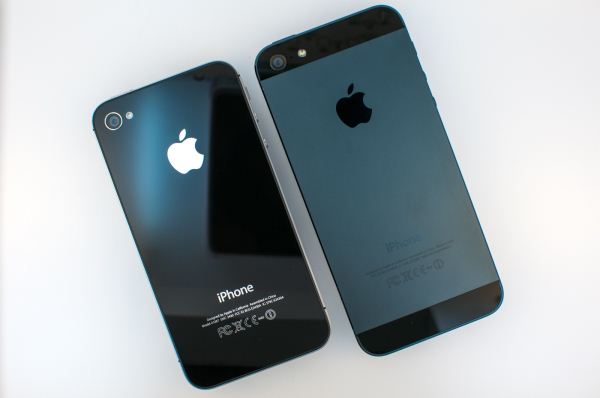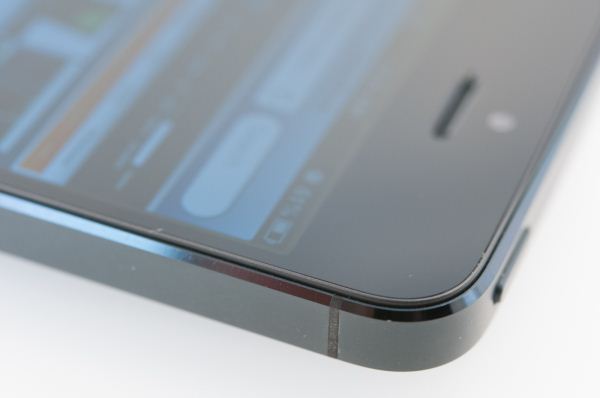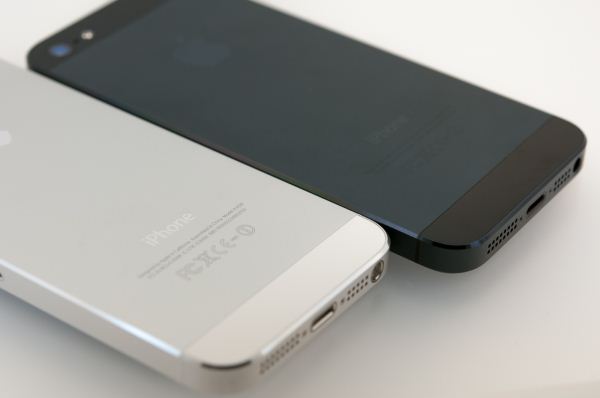The iPhone 5 Review
by Anand Lal Shimpi, Brian Klug & Vivek Gowri on October 16, 2012 11:33 AM EST- Posted in
- Smartphones
- Apple
- Mobile
- iPhone 5
Design
Section by Vivek Gowri
The iPhone 4, when it launched, represented a clean break for Apple's industrial design. It replaced the soft organic curvature of the iPhone 3G/3GS with a detailed sandwich of metal and glass, something that arguably brought the feel of a premium device to a new level. Obviously, Apple had their fair share of issues with the design initially, and nothing could match the sinking feeling of dropping one and shattering the glass on the front and back simultaneously, but it was a small price to pay for the jewel-like feel of the device. Combined with the (at the time) incredible pixel density of the then-new Retina Display, the iPhone 4 was a revolution in hardware design. The chassis has aged remarkably well over the last two-plus years, so naturally it's a hard act to follow.
The 5 keeps a similar design language to the 4, keeping roughly the same shape as before but with a taller and thinner form factor. At first glance, the 5 actually looks almost the same as the 4, with an unbroken glass front face, prominent corner radiuses, the familiar home button, a rectangular cross-section, and metallic sides with plastic antenna bands. However, those metallic sides are part of an anodized aluminum frame that makes up a majority of the body, and that's where the industrial design diverges from the 4 and 4S.
In contrast to the predominantly glass body of the previous generation iPhone, the 5 is almost entirely aluminum other than the glass front face and two small glass windows at the top and bottom of the back. It's a return to the original iPhone/3G/3GS-style of construction, with the front glass clipping into a unibody chassis. It's a significant departure from the 4 and 4S, where the stainless steel band in the center was the main housing that the front and rear panels clipped into. That was pretty radical way of doing things, so it's not all that surprising to see Apple revert to a more conventional and less complex method for the 5.
The aesthetic is actually pretty awesome, especially in the black version. The combination of black glass and off-black aluminum (Apple is calling it slate) gives the 5 an almost murdered out look that's three parts elegant and one part evil. The white and silver model has a classy look that's much friendlier in appearance than the black one. The color schemes and overall design aesthetic remind me of the Dell Adamo, one of my favorite notebook designs of all time. The similarities may be purely coincidental, but it's interesting to note nonetheless and should give you an idea of how premium the industrial design is.
All three previous iPhone body styles had very similar dimensions, so the biggest question with the 5 was how much the larger display would do to change that. Unlike many Android manufacturers, Apple still believes in things like small pockets, small hands, and one-handed smartphone usage. With the 5 being vertically stretched but no wider than the previous iPhones, the biggest impact on in-hand feel is actually the thinner body. If you're used to a larger Android or Windows device, the change seems radical, but even compared to the 22% thicker iPhone 4S, it feels a good deal smaller.
It's not just the minimized z-height though, the 25% weight loss is definitely also a factor. Even a few weeks later, I still find it striking how much less substantial it feels than the 4 and 4S. The densely-packed glass body just had a reassuring weight to it that the 5 simply lacks. But as you get used to the new form factor, you realize how far Apple is pushing the boundaries of ultrathin design. When the 4th generation iPod touch came out, I told Brian that I wanted an iPhone with that form factor - well, the 5 is essentially there (0.3mm thicker and 11 grams heavier, but close enough). It's pretty impressive to think about. If you thought the 4S was one of the best phone designs on the market in terms of aesthetics and build quality, the iPhone 5 just pushes that advantage further.



















276 Comments
View All Comments
medi01 - Wednesday, October 17, 2012 - link
1) Compare ipad2's gamut, cough2) Check values on toms
http://media.bestofmicro.com/3/4/331888/original/g...
http://www.tomshardware.com/reviews/ipad-3-benchma...
Unlike anand, toms was beyond primitive contrast/brightness benchmarking for quite a while.
thunng8 - Thursday, October 18, 2012 - link
Not sure if I should trust Tom's figures compared to Anands's.In any case, both show the ipad3 has higher gamut, especially in sRGB.
steven75 - Wednesday, October 17, 2012 - link
I think what you meant to say is that AMOLEDs win on black levels and that's about it. LCDs still win in accuracy and most importantly ability to see them in outdoor settings.KoolAidMan1 - Tuesday, October 16, 2012 - link
Not even close. Even the better Android displays like the Galaxy S3 has a PenTile display. Despite having more "pixels" it actually has fewer subpixels than the iPhone does. Unless you have bad eyesight the S3 display looks really bad in comparison, and this is before we get to even worse smartphone displays out there by HTC, etc.Sufo - Tuesday, October 16, 2012 - link
Old pentile displays were visibly jaggy on vertical lines - even my old lumia 800 exhibited this to some extent. On the GS3 tho, it is not noticeable and it has nothing to do with eyesight.Your comment makes it sound (to someone who has seen many different smartphone displays in person) as though you haven't spent much time with the GS3 (read: many smartphones) at all. Simply mentioning that is uses pentile subpix config, from you, sounds like regurgitated information. Not only that, but you seem to gloss over the many benefits that amoled panels bring. It's arguable that these benefits are more important than an accurate colourspace on (specifically) a mobile phone - although it is ofc entirely subjective.
This brings me to the last tell of ignorance I noted; your mention of HTC. Have you used a One X? For those who do not like amoled panels, the display on the one x is perhaps nicer than both the gs3 and the ip5. Ofc you may say Android is not your cup of tea, and that's a perfectly justifiable stance, however it has nothing to do with display tech.
tl;dr You sound like you don't know what you're talking about
KoolAidMan1 - Tuesday, October 16, 2012 - link
I do know what I'm talking about given that I've seen many smartphones, and I've calibrated my share of desktop displays to sRGB.Differences in display tech aside, Android phones have never gotten color profiles right, EVER. They're almost always oversaturated, have too much contrast, and are inaccurate. Anand even posted a difference in color accuracy between several devices, and the profile for the S3 is totally what I expected.
The S3 really doesn't look good, period, but then again there are people who argue that TN panels are just fine against IPS. I'm used to hearing nonsense on forums when it comes to display from people who don't know what to look for.
KoolAidMan1 - Tuesday, October 16, 2012 - link
BTW, apologies if that came out harsh, but the difference in color and contrast accuracy between something like the S3 and a properly calibrated device is a night and day difference to me. I'm pretty sensitive to display quality though; my main desktop display at home is still an NEC and my plasma is a Pioneer Elite (RIP)rocketbuddha - Tuesday, October 16, 2012 - link
For Android you have the following 720p HD DisplaysSLCD - HTC Rezound (2011 tech)
SLCD 2 - HTC One X, Sony HD
HD SAMOLED Pentile - GS3, Galaxy Nexus, Moto Razr HD
HD SAMOLED RGB - Galaxy Note II
True IPS LCD - LG Optimus 4X, Optimus G
Super IPS LCD -Asus Padphone, Sharp phones etc
So you have big set of choices. If dark contrasts are important then SAMOLED is the way to go. SAMOLED RGB over SAMOLED Pentile.
If overall color and whites are important go with SLCD2.
IPS LCDs are the closest to the Retina Display and u have a choices there too. You can pick and choose what is good for you and have alternatives.
Spunjji - Thursday, October 18, 2012 - link
The HTC One X has what is hailed to be one of the best LCD smartphone displays out there. Your claim is invalid.Similarly, the Galaxy Note 2 has an AMOLED display without PenTile. Sure, it's lower density, but one does not hold a 5.5" screen so close to one's face.
medi01 - Wednesday, October 17, 2012 - link
""The iPhone 5 display is better than any current Android display.""Why don't you go hit your dumb head with something heavy, ipad would do?